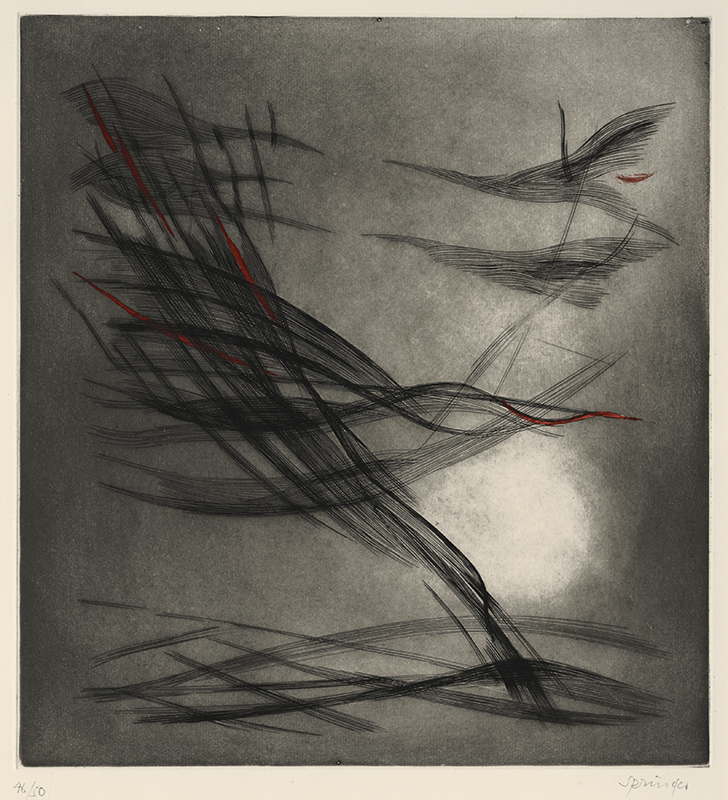Clair obscur is an engraving and aquatint with hand coloring created in 1959 by the French artist Ferdinand Springer. This impression is pencil signed and editioned 46/50. It was published by Atelier Lacourière et Frelaut, Paris and is printed on cream Arches wove watermarked paper. The reference is Höfchen 139 and the platemark measures 12-1/2 x 11-11/16 inches.
The artist also used Clair obscur for the title of a painting and the term translates to clear and obscure. Springer was a master of the burin and, with this intaglio, he used the burin to create dark, flowing sensuous lines which are offset by a soft orb of light in the lower right of the image. The lines can remind one of birds in flight or a storm diving out of the heavens in an attempt to touch the upon the earth. Graceful lines and the limited palette combine to create an image of sophistication and elegance.
Ferdinand Springer, painter and printmaker, was born to a German father and a Swiss mother in Berlin on October 1, 1907. After graduating from high school in Potsdam, he studied art history at the University of Zurich. He began painting in 1927 and visited Milan where he met the Italian painters Giorgio Morandi and Carlo Carrà.
Springer
moved to Paris in 1928 where he studied with Roger Bissière at the Académie
Ranson. In 1932, he learned intaglio techniques at Atelier 17 in Paris and, in
1937, he traveled to New York where he exhibited at the Julian Levy Gallery.
During this time he met Alexander Calder and Salvatore Dali. Springer’s wife
was Jewish and his father wanted him to sign papers denouncing her to the Nazi
government which he refused to do. After moving to Grasse in southern France in
1939, Springer was interned by the Nazis, along with Max Ernst, Hans Bellmer
and Otto Wols at the Camp des Milles near Aix-en-Provence.
After his release in 1940, Springer returned to Grasse and started the “Grasse Group” with Hans Arp, Sonia Delaunay, Alberto Magnelli and others, and produced his first abstract works. With the escalation of the war Springer escaped to Switzerland in 1942 but was not allowed to exhibit his work. He returned to Grasse in 1945 to discover that of most his work was lost.
In
1946, Springer created engravings for Paul Valery’s Eupalinos VI, and in 1952 he relocated to Paris and returned to
painting in 1955. He resettled in Grasse in 1960 and became
a pioneer in the revival of printmaking, along with Johnny Friedlander, Pierre Courtin,
and Henri-Georges Adam. He continued to work and to exhibit throughout Europe
and the United States, and in the early 1990s began focusing on painting large
canvases.
A retrospective of Springer’s oil paintings, watercolors, drawings, engravings, tapestries, and sculptures, created between 1929 and 1967, was presented at the Kunstverein Heidelberg in 1967. That same year, André Malraux, as Government Minister of France, awarded Springer the medal Chevalier des Arts et des Lettres.
Springer's
work is represented in the collections of the Kunstmuseum, Basel; the
Kunstmuseum, Bern, Switzerland; the Kunsthalle Bremen, Germany; the Brooklyn
Museum, New York; the Fogg Art Museum, Cambridge, Massachusetts; the Cincinnati
Art Museum, Ohio; the Yale University Art Gallery, New Haven, Connecticut; the
Museum of Modern Art, New York; the Musée National d'Art Moderne, Paris; the
Bibliothèque nationale de France, Paris; the Musée des Beaux-Arts, Rouen; the
Fine Arts Museums of San Francisco, California; and the Library of Congress,
Washington, D.C.
Ferdinand Springer died on 31 December 1998 in Grasse, France.



